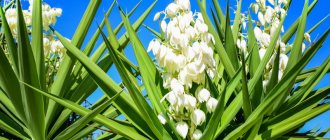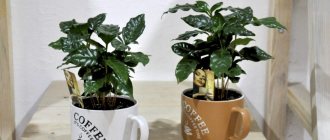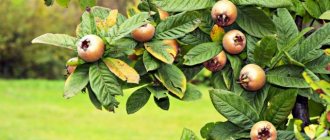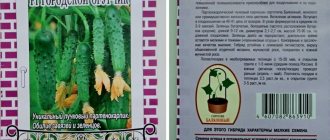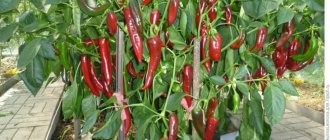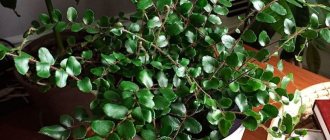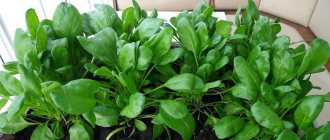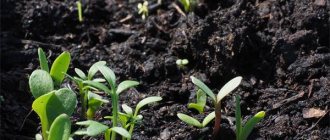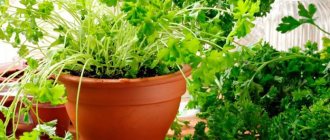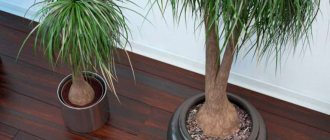Category: Care Published 04/17/2019 · Comments: · Reading time: 8 min · Views: 2,582
At one glance at this plant, it becomes clear that this guest came to us from distant countries, his appearance is so unusual and original. The nolina palm tree has a lignified trunk, which has a large caudex at the base - a reservoir of water and a lush, voluminous crown, consisting of a huge number of narrow and oblong leaves. Because of such a unique appearance, nolina received various “nicknames”; people call it “horse tail”, “elephant foot” and even “bottle tree” or “bottle palm”.
This amazing representative of tropical flora could not help but interest flower growers, and practice has shown that it adapts perfectly to home conditions. Where does the nolina palm come from, is the plant a palm tree and how to properly grow it away from its native tropics?
Origin and characteristics of bocarnea
Where did this natural miracle come from in our apartments?
Even an ultra-fashionable phytodesigner would not think of bringing to life such forms as the nature of Mexico did by creating nolina. By the way, in its homeland this plant, known to people for more than a century, reaches 10 meters and blooms in white fragrant clusters, and its rather hard leaves are used for weaving hats and baskets. Of course, in indoor conditions you will not see such a giant - the maximum that can be achieved is 90 centimeters in diameter and 2 meters in height, provided that you can provide suitable care throughout the 6-7 years of the plant’s life. An adult indoor nolina is an outdoor plant. The unpretentious bocarnea nolina adapts to different temperatures and does not suffer from proximity to heating radiators, but does not like drafts. In addition, three varieties of “bottle tree” are found in indoor culture.
Planting and fertilizing
Many people ask how to grow nolina plant at home. Everything here is extremely simple - with proper care, it will grow in 5 years and become a large outdoor tree. In general, there is no need for fertilizing. But if you wish, you can add a diluted infusion of organic fertilizers.
To plant the plant, use a wide and shallow container. The thing is that the roots grow not in depth, but in width.
Prepare a layer of small stone or expanded clay above the “water” hole. This way, the water will not stagnate, and the root system will become healthier. The surface layer of soil can also be supplemented with fine gravel to prevent the formation of a crust.
Types of nolina (bocarnea)
Nolina recurvata , or Beaucarnea recurvata . The trunk is erect, expanding downward, forming a bulbous thickening. Under natural conditions, the trunk reaches a height of 8-10 m, the base is up to 1 m in diameter. In a greenhouse-room culture, the height of the plant often does not exceed 1.5 m. In the upper part of the plant there is an abundant sheaf of dense linear leaves, reaching almost two meters in length. In its native Mexico, the long and strong leaves of nolina are used for weaving baskets and the famous sombrero hats. The lower part of the stem is exposed and covered with a smooth, grayish cork tissue that protects against water evaporation.
Nolina longifolia is found in greenhouses and parks on the Black Sea coast of the Caucasus and Crimea. There you can admire the long inflorescences of nolina from numerous small flowers.
Small-fruited nolina (Nolina microcarpa), like long-leaved nolina, is found in greenhouses and parks on the Black Sea coast of the Caucasus and Crimea. It also has long inflorescences of numerous small flowers.
Types of bocarnea, homemade nolina with photos and names
There are approximately 30 species of bocarnaea in the wild. Only a few of them can be grown at home.
Nolina recurvata
The most common type of homemade bocarnea. The height of an adult tree can reach 2 m, the diameter of the thickened part of the trunk is about 1 m. The top of the trunk is “decorated” with sinuous elongated (up to 100 cm) leaves. The dark green leaf blade is narrow (up to 20 mm) and dense. The plant is called “elephant’s foot” based on the shape of its trunk, and “horse’s tail” based on its lush crown.
Nolina Lindheimeriana
A low tree. The trunk is almost invisible. The top is crowned with a lush tuft of elongated narrow leaves, colored light green. The popular name is "devil's lace".
Nolina longifolia
Large powerful tree. The height reaches 4 m. The texture of the trunk resembles a cork covered with cracks. The leaf blades are wide (up to 4.5 cm) and elongated. They have a light green tint.
Bokarneya is a welcome exotic in the house. A stylish plant emphasizes the individuality of the interior, bringing sophistication and elegance to it.
Nolina recurvata or bent - Beaucarnea recurvata
An evergreen perennial succulent that forms a caudex at the base of the trunk. In the natural environment, this subspecies reaches a height of 9 m and is large trees with weakly branched trunks, at the tops of which there is a lush crown of light green, long, drooping leaves. The peduncles are erect, appear at the tops of the shoots, and bear large, branched inflorescences with small greenish flowers. Flowering in nature occurs 2 - 3 times a year. Currently, a subspecies has been bred for growing indoors - nolina curly . These plants are distinguished by beautiful, thin, curved leaves, reaching 1 m in length.
Botanical description
Nolina (lat. Nolina) belongs to the Asparagus family of plants, mainly growing in natural conditions in the southern United States and Mexico. Another botanical name for the plant is Bocarnea, and it is popularly called “Horse Tail” because of the shape and arrangement of the leaves, or “Elephant Foot” because of the shape of the trunk. Indoor nolina is usually a low plant. This is a bottle plant - the nolina trunk expands at the base. This extension serves as a water reservoir that helps the plant survive long dry periods, and the thin leaves allow moisture to evaporate slowly, making the plant resistant to moisture stress. Growing the plant is quite simple. The pot needs to be shallow, since the root system does not go deep - in nature, nolina grows on rocky soils. The plant is grown as an ornamental deciduous plant, since it is almost impossible to achieve flowering indoors. Looks good as a single plant.
Nolina Nelson - Nolina nelsoni
In nature, this variety reaches a height of 3.5 m and forms weakly branched, strong, thick trunks covered with light brown bark. At the top of each trunk there is a lush cap - a crown, consisting of narrow, linear leaf plates. The leaves are green, in most cases covered with a bluish waxy coating. There are tiny teeth along the edge of the leaves.
Nolina transplant
After purchasing and planting, nolina needs to be replanted every year until it reaches adulthood. For adult nolins, transplants at intervals of once every 4 years are sufficient. After the transplantation procedure is completed, watering should not be carried out for 3-5 days.
The transplanting soil should be loose. The most suitable substrate is a mixture of leaf soil, peat and sand in equal proportions; garden soil and small crushed stone will also cope well with this role. Ensuring good drainage is an important component of both growing and replanting nolina, so a layer of small pebbles (which can be gravel) is indispensable.
Nolina care
Lighting. Nolina is a rather unpretentious plant, and growing it is not difficult even for beginners who like indoor floriculture. She feels best in a bright place, but direct sunlight should be avoided. In the autumn-winter period, it is necessary to illuminate the plant with fluorescent lamps.
Temperature. In spring and summer, nolina (bokarneya) tolerates room temperatures well. At all times it is necessary to ensure that there are no drafts; she tolerates them very poorly. In summer, the plant can be taken out into the open air, but it should be positioned so that it is protected from wind and rain.
In the autumn-winter period, in order for the plant to enter a dormant period, the temperature is gradually reduced to 10°C. Provided that you have experience in growing cacti and succulents, you can keep nolina from November to January at a temperature of 3-5 ° C, at this temperature optimal conditions for the dormant period are created.
In their homeland, nolins grow at altitudes of about 3000 meters above sea level, where at night the air cools to negative values, so they can tolerate fairly low air temperatures. Most often, in room conditions, not everyone has the opportunity to provide Nolina (Bokarnee) with the appropriate temperature for the rest period, and she is kept without it. At room temperatures, the plant does not enter a dormant period and continues to grow; during this period it is necessary to provide the nolina with good lighting.
Watering. In the summer-spring period, nolina (bokarneya) should be watered abundantly, it is advisable to use bottom watering (dip the pot with the plant into a container of water, and remove it when the top layer of the substrate begins to shine, allow excess water to drain and place it in a permanent place). The next watering should be done when the earthen ball is completely dry. If you keep nolina in the fall and winter at room temperatures, without a dormant period, it should be watered in the same way as in the summer. At higher temperatures in winter, increase air humidity and periodically lightly spray the leaves. Watering should be limited (at temperatures of 10-15°C) or stopped completely (at temperatures below 10°C) if you keep nolina at low temperatures and it is in a dormant period. We should never forget that excess water for nolina, as for all other desert plants, can be fatal (waterlogging in winter is especially dangerous; to avoid this, many gardeners use drip irrigation).
Spraying. In indoor conditions, nolina does not require spraying, but the leaves must be periodically wiped with a soft, damp sponge. In nature, nolins obtain water by collecting abundant dew, characteristic of their habitats. Their long, groove-shaped leaves serve as moisture collectors, through which drops of dew flow down to the center of the crown and then along the trunk to the roots. In this way, the nolins compensate for the constant shortage of rainwater characteristic of their homeland. You can simulate dew by spraying the crown with warm boiled water. But don't do it on a hot afternoon. The best time is morning or evening hours.
Fertilizer. Nolinas grow quite quickly in the first years and by 6-7 years in good hands they turn into large outdoor plants. Therefore, the use of additional fertilizing does not make much sense. If you still want to feed your plant, then use liquid mineral mixtures. Feeding is done once every three weeks. Make the concentration of the finished fertilizer 1.5-2 times lower than indicated on the package. It is clear that all fertilizing can be done only during the period of active plant growth and only after abundant watering with clean water. Excess nitrogen leads to decreased leaf hardness. You can feed it with a very diluted infusion of organic fertilizer (mullein is diluted in a ratio of 1:20).
Landing. To plant nolins, they always use rather tight dishes, wide but shallow. There must be a hole in its bottom for water drainage. A rather high drainage layer of small pebbles or expanded clay is placed above it. All this will avoid the formation of stagnation of water, which inevitably leads to rotting of the roots. The roots of nolina grow in breadth, but not in depth (in its homeland, this unusual plant is found on rocky soils with a shallow fertile layer). For this reason, nolins require wide containers and good drainage. You can pour a layer of fine gravel on the surface of the soil, which will prevent the formation of a crust and emphasize the decorative qualities of nolina.
Transfer. Transplantation of nolins is done only after the roots have completely entwined the clod of earth. Young plants are replanted every year, adults - once every 3-4 years. Planted at the same depth as it was before. After transplantation, nolina should not be watered for the first 3-4 days. To speed up growth, once a year in the spring it is recommended to transfer the young nolina to a larger pot (2-4 cm larger in diameter). The soil mixture needs to be loose, for example, peat, leaf soil, sand in a ratio of 1:1:2, or: turf soil, leaf soil, humus, peat and sand (1:1:1:1:1). You can make a mixture of garden soil and coarse sand with the addition of fine crushed stone.
Nolina is a suitable plant for the hydroponic growing method.
Reproduction. Propagating nolina is quite difficult. The main method is sowing seeds, which is what producers in Holland do. If you purchased several nolins in one pot, you can plant them in separate pots. Sometimes lateral buds emerge at the base of the shoot, and shoots emerge from them. You can try propagation by lateral shoots.
Seed propagation of Nolina (Bocarnea):
The seeds are soaked in warm water for 24-48 hours; you can soak them in epin or zircon. Planted in a moist substrate consisting of peat and sand (1:1 ratio). The seeds are laid out on the surface and sprinkled with a thin layer of soil, but so that the sealing layer is equal to the size of the seed. For the germination of nolina seeds, light is needed; the container with the seeds is placed under fluorescent lamps.
The optimal temperature for germination is +21-25 degrees, not lower than 20. Usually seeds germinate in 3-4 weeks. It is necessary to monitor the humidity of the substrate; it should not be too wet, the optimal state is moderately wet. The container with seeds can be covered with glass or a bag; if condensation appears, it is necessary to ventilate the bowl by removing the cover.
When the seedlings become stronger, they are planted in individual pots corresponding to the size of the nolina seedling. The soil mixture needs to be loose, for example, peat, leaf soil, sand in a ratio of 1:1:2, or: turf soil, leaf soil, humus, peat and sand (1:1:1:1:1). You can make a mixture of garden soil and coarse sand with the addition of fine crushed stone. You can also use ready-made substrates for Nolina.
Further care as for an adult plant.
Reproduction by shoots:
When propagating by lateral shoots, carefully break off the lateral shoot. They are rooted in a moist substrate consisting of peat, sand and perlite (vermiculite). The pot is filled with a wet mixture, pressed down and indentations are made with a peg. A shoot is planted in the recesses and the soil around it is pressed down. Cover the planted shoot with a transparent cap and place it in a warm place. It is necessary to maintain the temperature within 21-26°C, constantly spray and regularly ventilate. When new leaves appear on the rooted plant, the cap is removed, and the young plant is gradually accustomed to the new conditions of care.
Nolina - signs and superstitions
According to the teachings of Feng Shui, all plants influence a person to a certain extent. Thus, the appearance of bocarney in the neighborhood promises only positive changes for those around you. The flower brings harmony and a calm life to the family. All succulent varieties, including the bottle tree, suppress outbursts of anger and unreasonable rage in humans.
It is recommended to place the flower in the living room or in the corridor - where there are a lot of people.
Nolina is a succulent plant with an unusual appearance and simple growing conditions. The flower tolerates bright light and high temperatures well; in winter, a period of rest and a decrease in temperature to +10 degrees is required. Nolina leaf juice is the best remedy against insect pests. Particular attention should be paid to the watering regime - excess moisture should not be allowed and watering should be adjusted depending on the time of year and the conditions of the flower.
Possible difficulties
The leaves have become smaller, turn pale and sag easily: The reason may be a pot that is too small or a lack of light and increased temperature.
The tips of the leaves have turned brown: The reason is that the air in the room is too dry.
As with other “bottle trees,” for nolina the ratio of trunk diameter to height is the result of external conditions. The more abundant watering and less light, the greater the length of the trunk to the detriment of its thickness. To form a natural appearance in the form of an “elephant’s foot”, periods of drying out the earthen clod and good lighting will be required. From excess moisture, nolina can develop mold diseases, and the trunk can rot .
The hard and succulent leaves of nolin are inaccessible to most pests of indoor plants. But sometimes nolins suffer from spider mites and scale insects. This usually happens in rooms that are too warm and dry. The best way to avoid this is to lower the winter temperature to at least +8-10°C and spray and wash the leaves more often.
Possible difficulties when growing nolina
These tropical plants are quite hardy and most often ailments occur only with improper care and serious disturbances of the microclimate:
- Shrinking, paleness of foliage - the rhizome has become cramped in the old pot or the palm tree is hot and there is not enough light.
- The tips of the leaves turn brown - the air in the room is too dry.
- The trunk stretches out and becomes thinner - excessive watering with insufficient lighting is to blame.
- Mold appears as a result of regular waterlogging of the soil.
Nolina's foliage is hard and succulent, and is therefore unattractive to most parasitic insects. However, against the background of increased air temperature and excessive dryness, spider mites or scale insects may appear on the plant.
They can be removed by treating the palm tree crown with a soapy solution. In case of severe infection, it is necessary to use special chemicals. Prevention of infection - cold wintering and spraying the foliage with warm water.
Tips on how to grow nolina: how to care for and prune the plant
Caring for nolina, or bakorneya, is not a difficult task, since due to its structure the plant is quite tolerant of stressful environmental conditions. Use the tips below to grow a healthy flower.
Nolina is not afraid of direct light, and even more - the flower will feel best if it receives sunlight for at least a few hours a day. Daylight should be quite long - at least 12 - 14 hours. In winter, when the time of natural light is much shorter, it will be necessary to take care of additional ones. This can easily be done using fluorescent lamps. In order to grow a healthy nolina, like all light-loving plants, it is better to place it near a south window. It is unlikely that it can be placed on a windowsill, but it cannot be placed in a corner either - in the shade the plant develops much more slowly, as it feels uncomfortable with insufficient light. In the warm season, you can take the flower outside, but it is important to choose a location where there will be no drafts. Exposing the plant to rain is also undesirable.
Before you start caring for nolina, you need to establish optimal growth conditions for the flower, as well as temperature conditions, depending on which care will need to be carried out. In the summer, the plant will feel best at 22 - 27 °C. However, it can introduce higher temperatures without any problems.
In winter, it is recommended to keep it cool at a temperature of 10 °C. If the wintering is colder, it is necessary to stop moistening the soil. This will bring the flower into a dormant state. However, the plant can be left in the living room. In this case, it is necessary to take care of additional lighting.
Undemanding to air humidity. However, in extremely dry conditions, especially when located near heating devices, the tips of nolina leaves may begin to dry out. Therefore, it is still advisable to spray the plant from time to time. It can also be bathed under warm water, while covering the soil with polyethylene. However, it is not worthwhile to go through such a procedure. It is best to use soft and purified water.
The substrate is prepared from medium-heavy soil: turf, leaf and greenhouse soil, sand (3: 1: 1: 0.5). It is desirable that the top part of the soil is loose.
As for watering, at home caring for nolina, or, as it is called, bokarneya, should reproduce the amount of moisture it receives in the natural environment. The plant does not tolerate dampness well and is quite tolerant of short-term drought. Not only excessive watering, but even drops falling on the trunk and too humid air can lead to rotting of the nolina. Regular watering as the soil dries out. It is important that the earthen lump has time to dry completely. To do this, you need to bury your finger 3–4 cm into the soil; if it is completely dry, you can moisten it. The optimal way to water the soil is quite unusual - you need to place the pot in a basin with well-settled water and wait until the earthen ball becomes wet. If the plant is already mature and quite large in size, then you can water it in the usual way. However, you should ensure that water does not get on the trunk under any circumstances. At the same time, the leaves, on the contrary, need to be regularly wiped with a wet cloth. It is necessary to reduce the amount of moisture consumed by the flower with the onset of autumn. In winter, watering is moderate and depends on whether the plant was put into dormancy.
During the growing season, the plant is fed monthly with cactus fertilizer. The diluted fertilizer must be poured at some distance from the trunk, otherwise the flower will get burned. At home, when caring for a nolina flower with the help of fertilizing, you can notice that with the use of a large amount of fertilizers, the crown of the plant begins to develop well, and the caudex of a small one begins to develop well.
At home, it is necessary to replant nolina every 2-3 years if the plant is mature and has already reached its maximum possible size. The young flower is replanted every year. Considering that the root system of this plant is located in the upper layers of the soil, it is necessary to choose a pot that is shallow but wide. There must be holes at the bottom for water drainage. It is not recommended to quickly switch from a small container to a large one - every year it should become 3-4 cm larger in diameter. The new soil for replanting nolina should have a slightly acidic reaction, have good air permeability and be sufficiently fertile. The plant will take root best in a new pot if you do not carry out any procedures to moisten the soil a week before moving and a week after it. You should also remove most of the old earthen ball. It is important not to forget to inspect the root system - this way you can detect a problem with root rotting and eliminate it. During replanting, nolina can be pruned as soon as any damaged areas of the plant are detected. Diseased shoots or leaves are cut off with a sharp knife as close to the base as possible. Before moving the plant into a new vessel, it is necessary to pour a drainage layer on its bottom, which will not allow excess moisture to stagnate in the soil for a long time. For this purpose, you can use expanded clay and broken bricks. The space between the walls of the pot and the roots is filled with pre-prepared substrate. When transplanting, under no circumstances should the caudex be buried in the ground. If possible, the roots should be spread over the area of the pot. Caring for nolina after transplantation at home is essentially no different from usual, you just need to remember that the plant cannot be watered for a few more days.
Note to the florist
Nolina is a beautiful and unpretentious plant that also has health benefits:
- Nolina improves indoor air, enriching it with oxygen, ozone and air ions.
- The plant helps household members strengthen their immune system and get sick less.
- Nolina creates psychological comfort in the room and calms the nervous system of the people living in it.
Plant lifespan
Beaucarneya is long-lived by nature. If you follow the regime of alternating active growth and rest, the plant can live for more than a century even at home.
Is this flower poisonous?
There is no information about the danger of human and animal contact with this plant. Cats often chew leaves.
Why doesn't it bloom?
Nolina does not bloom in indoor conditions. If you follow the regime she needs, flowering is possible after 15 years of age.
Why don't new leaves grow?
The plant may be dormant. At this time, growth slows down, greenery does not increase. In this condition, you need to reduce watering. The appearance of new leaves will indicate a way out of this state.
How does the plant overwinter?
For proper wintering, you need to create cooler living conditions, provide bright light and stop watering. If this is not achievable, then she will endure other conditions proposed to her.
Why do nolina leaves dry out?
- The tips of the leaves dry out. The problem occurs if the plant is kept in a room with dry air. In such a situation, it is enough to spray the flower, but avoid getting water on the trunk. Otherwise, dark spots appear on the trunk and it rots. It can also be caused by insufficient watering or lack of nutrients in the soil.
- The leaves are withering. The reason lies in insufficient lighting. In summer, you need to choose the brightest window in the house, and in winter, use an additional source of lighting.
- The lower leaves dry out. This process is natural and should not cause concern.
- The trunk of the plant dries up. This occurs due to loss of moisture after wintering. The plant's normal appearance will be restored immediately after the normal watering regime is resumed.
Why is nolina growing slowly?
- Few new leaves are formed. The reason is lack of nutrients. Feeding the flower or replanting will help solve the problem.
- New leaves are small. This happens if nolina grows in a cramped pot, lacks lighting and is exposed to high temperature.
Why does nolina have a green coating on its trunk?
It could also just be mineral deposits; you need to determine for yourself whether the “green grass” you noticed is a parasitic plant such as moss, or is it something else. Nolina is an unpretentious and not capricious plant.
Indeed, feel free to remove all the “green stuff”, change the soil, and thoroughly wash the nolina trunk with a brush when replanting. When working with the plant, remember that its leaves are cut. like a razor, so I advise you to wrap them in a towel, like hair after a bath - and you won’t damage the plant, and you won’t cut yourself.
Nolina loves the brightest sun you can provide her and lots of fresh air!
I advise you to keep it separately from other plants, on some individual shelf, it deserves it. It should be sprayed very occasionally, and only with warm water (and also watered). Watering, as they say, is moderate, don’t get carried away!
A method for growing nolina (bocarnea or bottle tree) from seeds at home
At home, any propagation of nolina is a rather complicated process, so many people simply buy the plant in the store.
There are two main ways to propagate this plant - using seeds and side shoots. Young plants grow very slowly after this. It may take several years for them to reach even 1 m in height.
Growing a bottle tree, that is, nolina, from seeds is not easy, but this method is the most popular among gardeners. Since this plant does not bloom in an indoor environment, seeds cannot be obtained naturally. However, they can be easily purchased from various online stores.
Before you start propagating bocarnea at home, the seeds must be kept in a weak solution of potassium permanganate for 2 days. If the soaked seeds are healthy and not infected with any fungi, they should sink to the bottom of the vessel.
The soil is best suited in the form of any fertile substrate and sand in equal proportions. The depth at which the seeds are placed should not exceed 1 cm, since otherwise it will be difficult for the sprouts to break through the layer of soil. After sowing, the container must be covered with glass or cling film and left in a warm place. This will help create greenhouse conditions. The room in which the seeds will germinate must be very well lit. It’s not bad if the soil is warmed up with direct sunlight for several hours a day. Maximum germination can be observed if the air temperature remains between 22 – 25 °C. Daylight hours for seedlings should last at least 12 hours. If natural lighting lasts less time, it is necessary to create artificial conditions using phytolamps. The soil must be moistened from time to time, while ventilating it. If you follow all the rules, you can observe the first shoots within 2 - 3 weeks after sowing.
At first, you need to grow nolina, sprouted from seeds, quite carefully, carefully adhering to all the rules of care, since the plant is still weak and the slightest mistake can lead to its death. You cannot remove the seed from the flower, as it will continue to feed on it for some time. When the time comes, the seed coat will fall off on its own. The glass from the container must be removed immediately after the first leaves appear. You need to be especially careful when it comes to watering - under no circumstances should you overwater the plant, as it will quickly begin to rot. When the flowers grow, they can be planted in separate pots.
Reproduction of nolina
Growing from seeds
As a rule, when grown indoors, gardeners prefer to propagate nolina by seed, despite the fact that it is quite complicated. To sow seeds, you need to take a substrate consisting of sand and peat (1:1). Immediately before sowing, the seed is placed in a solution of a growth stimulating agent or in clean water for 1–2 days. Then the seeds must be evenly distributed on the surface of the soil mixture, the distance between them must be at least 20 mm. Then they are sprinkled with the same soil mixture, and the thickness of the layer should be equal to the width of the seed. The pot is placed in a well-lit place, and at night the seedlings will need to be illuminated with fluorescent lamps. Crops should be kept warm (not lower than 20 degrees), but it is better if the temperature is kept at 24–25 degrees. The top of the container must be covered with film. Crops must be provided with systematic ventilation, which is carried out after condensation appears on the shelter. The substrate must be watered very carefully; there should be no stagnation of liquid in it, but it should also not be allowed to dry out. The first seedlings should appear within 4 weeks.
Strong shoots should be planted into individual pots, and the substrate should be used the same as when transplanting nolina (see above). Seedlings need the same care as adult bushes.
How to grow nolina from seeds? / bottle tree
Reproduction of nolina by shoots
To propagate such a crop, shoots are used. First, you need to carefully cut off a side shoot from the parent bush, then it needs to be planted in a container filled with a soil mixture that includes sand, vermiculite and peat (1:1:1). Take a peg and make a small hole in the soil mixture, place a shoot in it, around which the substrate is then thoroughly compacted. The pot must be placed in a warm (about 24–25 degrees) and well-lit place; the shoot should be covered with a glass jar on top. The cover must be systematically removed to ventilate the plant and moisten the substrate from the sprayer. After the flower grows a pair of young leaf blades, the shelter is removed for good, and the bushes are given the same care as adult plants.
Beaucarneya. Nolina. Elephant foot. Propagation by cuttings. Rooting in the ground.
Reproduction of nolina at home using lateral shoots
Reproduction of nolina using lateral shoots is the only way to obtain new specimens from a flower already growing in the house. Additional shoots appear when dormant buds emerge under the plant’s bark. They are cut as close to the trunk as possible. After this, the cut areas must be powdered with activated carbon and the cuttings thus obtained must be dried for 5–6 hours. The size of the shoot for normal reproduction should be within 8 - 10 cm. It is advisable to get rid of the lower leaves of the shoot, while a few upper ones can be left. To ensure that rooting is successful, the lower part of the shoot can be dipped in a phytohormone. After this, it must be placed at a slight slope in specially prepared soil. The planted shoot is covered with polyethylene or a glass jar to create a greenhouse effect. As with sowing seeds, the container should be placed in a warm and bright place.
As shown in the video, when propagating nolina by lateral shoots, it is important to always be very careful about the amount of moisture consumed by the plant and ventilate the shoots:
After fresh leaves have begun to emerge, the shelter can be removed. There is a chance to grow this flower in this way if the root system is formed before the leaves begin to feel the lack of water.
Reproduction
The easiest way to grow a new plant at home is to buy nolina in a specialty store. All methods of plant propagation are troublesome and require serious time investment.
Propagation by seeds
After purchasing planting material, you must first select defective seeds. This can be done as follows: soak all the seeds for a day, and throw away those that end up on the surface.
For planting, you need to prepare wide, shallow bowls, fill them with a damp substrate, mixing sand and peat in equal proportions.
It is enough to place the seeds on the substrate, lightly press them down with your hands and cover them with glass on top. After this, the bowl should stand in a bright, warm place. Such conditions are most comfortable for seed germination. If there is not enough light, an additional light source is used. The duration of daylight for nolina seeds is at least 12 hours. It is necessary to regularly ventilate the bowl and maintain a comfortable level of humidity. Under such conditions, seed germination takes two to three weeks.
The glass can only be removed after the first few leaves have appeared. The watering regime should be as follows: it is better to dry the plant a little than to over-moisten the soil.
When the plants become stronger, they can be planted in a permanent growing location.
You cannot remove the seed shell yourself, since the young plant feeds on the reserves contained in the seeds. When the plant is strong enough, the seed coat will fall off on its own.
Propagation by lateral cuttings
This method is complicated because side shoots appear quite rarely on the plant. If a shoot appears, it can be carefully cut off and rooted.
The cuttings are cut as close to the base of the stem as possible, and the cut site is treated with crushed activated carbon. The cuttings are dried for five hours. It is better to trim the bottom row of leaves; you can leave only a few top leaves.
The substrate for planting should be light; soil for seeds can be used. The substrate around the cutting needs to be crushed a little, cover the plant with film or glass and place the pot in a warm and bright place. Until the cuttings are completely rooted, it is important to monitor the level of soil moisture and regularly ventilate the room. When young leaves appear, the shelter can be removed.
What and when to feed bocarna
In principle, bocarney is indifferent to fertilizing, but to maintain health and decorativeness during the active growing season, fertilizers are applied once a month. Special products for cacti and succulents with a low nitrogen content are suitable. The concentration of the drug is halved compared to the manufacturer's recommendations. You can feed bocarna and organic matter, alternating it with mineral fertilizers. In this case, a very weak solution is prepared: fresh cow manure is infused for 3-4 days, then it is diluted with water 1:20.
Excess nitrogen can cause leaf hardness to decrease. Their decorative effect is also lost.
Special fertilizers for cacti and succulents are quite suitable for Bokarna.
Nolina feeding
The growth of nolin at a young age is characterized by a fairly rapid pace. As a result, by 6-7 years, with skillful care, they become large outdoor plants. This assumes that there is no need for additional feeding, although, if desired, it can be done periodically (once every 3 weeks) for these purposes.
Use liquid mineral mixtures, reducing the fertilizer concentration recommended in the instructions for use by 1.5-2 times. Fertilizing can be done only during active growth and is done only after abundant watering.
Diseases and pests
The “bottle palm” has excellent immunity, protecting the plant from diseases and pests. However, it can also be affected by such a common parasite as the mealybug, also known as the hairy louse or pseudococcida. They can be removed with a napkin or swab soaked in alcohol.
In addition, thrips, scale insects or spider mites can be found on the flower, which appear on both sides of the foliage. As a result of infection, the leaves become deformed, they turn yellow and die.
The parasites are removed with a cloth soaked in soapy water, and then the affected areas are treated with insecticidal preparations, Karbafos or Actellik.
To avoid such troubles, it is recommended to carry out preventive treatments of the plant with fungicidal agents, as well as adhere to the rules of care and maintenance of this exotic flower.
Nolina from seeds
Propagating nolina by seeds usually does not cause any difficulties. Before sowing, you need to disinfect them with a solution of potassium permanganate and disinfect the soil in the microwave.
Sowing is carried out to a depth of 1 cm in a moistened substrate, then the seed container is placed in a warm place, for example, above heating pipes, and subsequently the soil is not allowed to dry out.
The seedlings that appear after a month must be placed in the most illuminated place; under no circumstances should they be fertilized. After another 1 month, the young animals should be seated in separate containers.
Table: how errors in bokarney care manifest themselves
| What does the plant look like? | Cause | Elimination |
| The leaves turn yellow and fall off. | The room is too damp. | Provide good ventilation and adjust temperature. |
| The trunk shrivels and becomes wrinkled, the leaves begin to dry out. | Overdried earthen lump. | Although bokarnia is drought-resistant, it still needs to be watered. |
| The tips of the leaves are brown. | Abundant watering. | Water the plant as recommended. |
| During the active growing season, new foliage grows very slowly. | Nutritional deficiencies | During the growth period, bokarnia needs to be fertilized. |
| Drooping and limp leaves that change color to darker. | Lack of lighting. | Move the plant closer to the light source or provide additional lighting. |
| Soft spots appear on the bocarnea trunk, the shoots become sluggish, and the roots rot. | Frequent waterlogging of the substrate and moisture getting on the trunk. The situation is aggravated by low indoor temperatures. |
|
| The lower leaves dry out and fall off, but the young ones grow well. | Natural aging process. | There is no need to do anything, the plant is healthy. |
| The trunk of the bocarney has become soft. | An irreversible process of rotting due to excess moisture. | If the trunk has rotted, the plant, unfortunately, cannot be saved. |
Nolina watering
This plant has adapted to collect moisture, and therefore in the summer months hydration is reduced to moderate watering - the lump of earth should be wetted completely and the procedure should be repeated only after the soil has completely dried, and not immediately, but after a few days.
With the onset of winter and the establishment of a cool environment, watering ends - these are the most pleasant resting conditions for the plant. If the temperature has not dropped, continue to water as usual.
It is also worth noting that nolina does not require spraying at home, but the leaves must be systematically wiped with a soft, damp sponge.
Types and varieties of nolina
The Nolina genus includes 30 species. Many wild varieties are grown domestically. The plant is considered unpretentious, but with all efforts it is impossible to achieve the beauty that wild specimens have. Flowering is no exception - this is rather nonsense.
Nolina bent . In the wild, the trees grow in eastern Mexico. Their size does not differ from other varieties of trees and stretches up to 8 meters, which cannot be said about domestic crops - 1.5. The beauty of indoor varieties is not inferior to natural ones. The leaves of the crown, as if tangled by the wind, fall down.
A feature of the species is its longevity. Botanists have found specimens that are 350 years old. You can buy nolina at a flower shop or greenhouse. It’s good to take varieties in your region, then adaptation and growth will be more successful.
Nolina is compressed . The species is native to central Mexico. If you compare it with a bent nolina, then the structure of a powerful trunk, which resembles a clay vase with protruding leaves, immediately catches your eye.
They are narrow and tough, some of the leaves curl like curls on the head. The plant is very hardy, tolerates drought and temperatures down to minus 5 degrees Celsius.
Nolina Microcarpa . Unlike its counterparts, it does not have a powerful trunk on the ground surface. The leaves, like fireworks, fly out of the ground and scatter in thin threads.
Flowering is also bright, when white buds with a yellow tint are collected in a spike. Even during this period, you can see long curly mustaches. Their originality lies in their length, up to 2 meters. The plant resembles a huge bouquet collected by a skilled gardener.
Nolina Matapskaya . The trunk of the plant is straight with green or blue leaves.
Nolina Parry . Natural specimens are not particularly tall; they grow only 1-2 meters. But plants are surprised by the distribution of rosettes; there may be several of them.
True if the barrel is deformed. One cannot help but mention the majesty of the small milky inflorescences in the form of a huge panicle that adorn the tree during flowering.
Their length compared to the trunk can be up to 4 meters. You can observe such exquisite beauty of the plant in April and May. The species is cold-resistant and can withstand temperatures down to minus 10 degrees C.
Nolina Guatemala . Bottle-shaped barrel. In the wild it stretches up to 5 meters. A large tree has a no less large caudex diameter - 4 m. The leaves are wide with a sharp tip, flowing down.
Nolina is thin . A species with a very strong and strong trunk, presenting the appearance of a huge, convex clay pot.
Nolina Longifolia . The tree trunk is straight and strong with cork bark. Older specimens branch greatly. In the areas where it grows, it is affectionately called Mexican grass tree. The leaves are long and narrow and tend to dry out, but not fall off, and cover the trunk right down to the ground.
Nolin Nelson . Frost-resistant species, can withstand temperatures of minus 12 degrees C. The leaves are bluish, stretch up to 70 cm in length. During spring flowering, new shoots are renewed and replace the main one.
CARE
The plant is considered very unpretentious, but certain conditions must be observed in order to achieve good and fruitful cultivation.
Lighting. Nolina is not afraid of direct sunlight. She needs bright lighting about 14 hours a day. Therefore, the best place in the house will be the southern window sill. Don't be afraid of burns; they won't appear in the sun all day. Plants can be exposed to fresh air, protected from drafts.
Temperature. The optimal temperature is considered to be +22…+27°C. It can withstand even more intense heat. Winter is a time of rest for the plant. They are provided with a temperature of +12…+14°C. If it is not possible to ensure a cool winter, you need to place the flower in the brightest possible room or use phytolamps.
Humidity. Nolina needs normal or slightly higher humidity. Dry air can cause leaf tips to dry out. It is advisable to give the plant a shower and regular spraying. The water you choose should be purified and soft.
Watering. Bocarnia should be watered sparingly if the soil is already half dry. Thanks to the liquid accumulated in the caudex, the plant can exist for up to a year without watering. In autumn, watering is reduced, and in winter they are not watered at all at temperatures of +10...+15°C.
Pests and diseases
It is rare for Nolina to contract diseases and pick up pests. But there are a number of signs by which you can find out whether a plant is sick or not.
- The appearance of thrips, scale insects and spider mites indicates a lack of light and excess moisture.
- Dry, inelastic leaves indicate high temperatures and dry air.
- The stem is wrinkled, the tips of the leaves dry out - this is a lack of moisture.
- The leaves are brown and fall off - excess moisture.
- Too slow growth - the plant does not have enough nutrition.
- Trunk rotting occurs due to overwatering.
- A thin trunk is possible due to lack of light and overflow.
- Yellowing of a small number of leaves may be a natural process; if the lower leaves of an adult nolina have dried out, then there is no need to worry.
- White coating at the base of the trunk - the hardness of the water with which the plant is watered is increased.
- The presence of cracks is due to excessive/frequent watering or excessive fertilizing.
- Pale, impoverished and thinning foliage - the plant needs to be replanted.
Despite such an extensive list of possible problems, raising Nolina will not be difficult.
